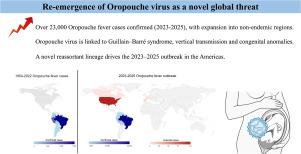Re-emergence of Oropouche virus as a novel global threat
IF 5.8
Q1 MICROBIOLOGY
引用次数: 0
Abstract
Oropouche fever is a viral infectious disease caused by the Oropouche virus (OROV), primarily transmitted by the biting midge Culicoides paraensis. Historically considered endemic to the Amazon region, particularly in Brazil, Peru, and Ecuador, Oropouche fever has resulted in an estimated 500,000 recorded infections. However, its true burden has remained largely unknown for over seven decades, serving as a classic example of a neglected tropical disease. In 2024, however, OROV rapidly expanded beyond its traditional Amazonian hotspots, spreading across Brazil and into other parts of South and Central America. Imported cases have also been reported in North America and Europe, underscoring its emergence as an escalating global public health concern. This literature review explores the historical epidemiology of Oropouche fever while shedding light on its rising public health relevance and emerging clinical challenges. The ongoing 2023–2025 outbreak has significantly affected Brazil, Peru, Bolivia, Cuba, and Panama and is linked to a novel reassortant OROV lineage that originated in the Brazilian Amazon. This new lineage has since established transmission chains throughout South and Central America, with international spread likely driven by increased human mobility and air travel. As of early 2025, over 23,000 confirmed cases have been reported worldwide, including five fatalities and clear evidence of viral expansion into previously unaffected regions. Alongside this viral geographic spread, OROV infection is increasingly associated with severe clinical outcomes, including Guillain–Barré syndrome and vertical transmission leading to miscarriage and congenital anomalies. The ongoing outbreak OROV reassortant lineage also demonstrates increased virulence, immune evasion, and enhanced viral fitness, likely contributing to their epidemic potential. Despite advances in surveillance during the current outbreak, critical gaps remain, including the absence of a standardized global lineage classification system, underscoring the urgent need for strengthened genomic surveillance, deeper insights into pathogenesis, expanded vector competence research, and innovative strategies for disease and vector control.

Oropouche病毒作为一种新的全球威胁再次出现
Oropouche热是一种由Oropouche病毒(OROV)引起的病毒性传染病,主要由副库蠓传播。Oropouche热历来被认为是亚马逊地区的地方病,特别是在巴西、秘鲁和厄瓜多尔,据估计已造成50万例记录感染。然而,70多年来,它的真正负担在很大程度上仍然是未知的,它是一种被忽视的热带病的典型例子。然而,在2024年,OROV迅速扩展到传统的亚马逊热点地区以外,蔓延到巴西和南美洲和中美洲的其他地区。北美和欧洲也报告了输入性病例,突出表明其已成为日益严重的全球公共卫生问题。本文献综述探讨了Oropouche热的历史流行病学,同时揭示了其日益上升的公共卫生相关性和新出现的临床挑战。正在进行的2023-2025年的疫情严重影响了巴西、秘鲁、玻利维亚、古巴和巴拿马,并与起源于巴西亚马逊的新型重组OROV谱系有关。此后,这一新谱系在整个南美洲和中美洲建立了传播链,其国际传播可能是由人类流动性和航空旅行的增加推动的。截至2025年初,全球已报告了2.3万多例确诊病例,包括5例死亡病例,并有明确证据表明病毒已扩散到以前未受影响的地区。除了这种病毒的地理传播外,OROV感染越来越多地与严重的临床结果相关,包括格林-巴-罗综合征和导致流产和先天性异常的垂直传播。正在爆发的OROV重组谱系也显示出增强的毒力、免疫逃避和增强的病毒适应性,可能有助于其流行潜力。尽管在当前疫情期间的监测工作取得了进展,但仍然存在重大差距,包括缺乏标准化的全球谱系分类系统,这突出表明迫切需要加强基因组监测,更深入地了解发病机制,扩大病媒能力研究以及疾病和病媒控制的创新战略。
本文章由计算机程序翻译,如有差异,请以英文原文为准。
求助全文
约1分钟内获得全文
求助全文
来源期刊

Current Research in Microbial Sciences
Immunology and Microbiology-Immunology and Microbiology (miscellaneous)
CiteScore
7.90
自引率
0.00%
发文量
81
审稿时长
66 days
 求助内容:
求助内容: 应助结果提醒方式:
应助结果提醒方式:


